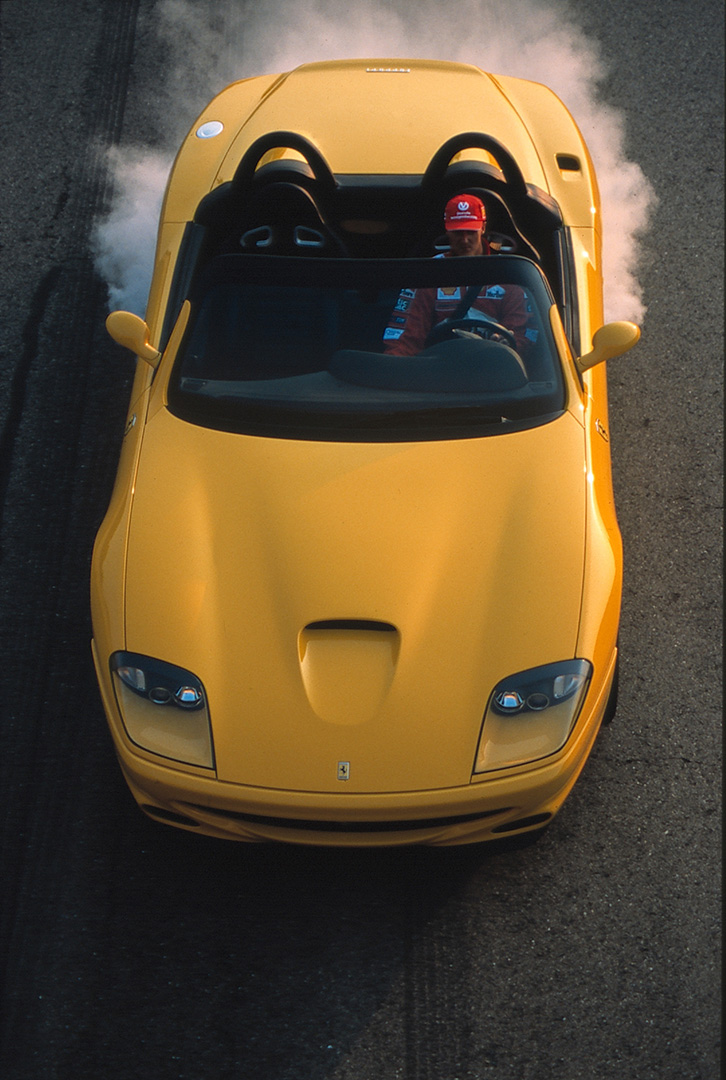?width=768&height=1024)
Ferrari 550 Barchetta Pininfarina
Unveiled at the Paris Show in 2000, the 550 Barchetta Pininfarina was so named to commemorate the 70th anniversary of Ferrari’s coachbuilder and stylist. A strictly limited edition of just 448 numbered cars was built, with the last leaving the factory in December 2001.

a unique interpretation of Ferrari’s purest and most extreme sports cars
A pure and functional front-engined V12 roadster in the tradition of cars like the 166 MM, the 550 Barchetta Pininfarina was equipped with a manual soft top for emergency use only. This simple expedient helped to keep the car’s kerb weight down to that of the coupé, despite the additional strengthening of the chassis.

The 550 Barchetta Pininfarina was specifically designed to be reminiscent of legendary Ferrari road race stars of the likes of the 166 MM, the 250 GT California and the 365 GTS4 Daytona. The aim, in fact, was to create an open-top front-engined 12-cylinder with a retro feel to it. The 550 Barchetta Pininfarina was designed and developed to be a unique interpretation of Ferrari’s purest and most extreme sports cars. In fact, it was a deliberate and provocative departure from the rest of the current range. As such, it was made available only as a limited edition of just 448, all of which were built in Maranello in 2001. Each car was numbered and its number displayed on a special in-car plaque signed by Sergio Pininfarina.
The 550 Barchetta Pininfarina was the perfect new millennium interpretation of the classic, open-top front-engined V12 Ferrari sports car, complete with modern styling and technology. One of its signature styling cues was a traditional barchetta-style cut to the windscreen (around 100 mm lower than the 550 Maranello) with a body-coloured finish to the lower section of the surround. It was also, tellingly, a model aimed exclusively at open-air use, providing just a manual soft-top for emergency use.

The functional and unadorned barchetta-type solution with a simple manual soft-top allowed Ferrari’s engineers to offset the additional weight gained by reinforcing the chassis and additional safety features (rear roll-bars). Consequently the 550 Barchetta Pininfarina weighed the same as the 550 Maranello. The 550 Barchetta Pininfarina’s exclusive design included other distinctive flourishes, such as Ferrari badges on the wheelarches, two-piece alloy wheels and an aluminium fuel cap. It was also available in any colour in the Ferrari range.
The car’s interior mirrored its thoroughbred, sporting character, with leather and carbon-fibre racing-style seats (which could be fitted with four-point racing harnesses on request if the market permitted). The driving position was ergonomically perfect, with the wraparound line of the dash attractively continuing across to the central tunnel and ensconcing the driver in an L-shaped cockpit. The sporty look was completed by the cabin’s carbon-fibre and black Lorica finish. Lorica was also used to trim the central tunnel and the rear bulkhead.
Lined with impact-absorbing material and trimmed in attractive leather, the rear roll-bars provided additional structural rigidity as well as protection for the occupants in case of an accident. The windscreen surround was also completely redesigned and incorporated a high-strength steel tube to withstand the car’s weight in a roll-over situation. The 550 Barchetta Pininfarina was powered by the very same 5474 cc 65° V12 as the 550 Maranello. It delivered 485 hp at 7000 rpm, with a maximum of 58 kg of torque at 5000rpm. The cylinder block, cylinder heads and sump were all light alloy with Nikasil-coated aluminium wet liners.

The con rods were made from Ti6a14V titanium alloy for maximum reliability at high revs during lengthy high-speed runs. The four-valve cylinder heads had hydraulic tappets.The design of the inlet and exhaust runners were directly derived from those used on the cylinder heads in Formula 1, providing the optimum balance between volumetric and combustion efficiency. Variable intake geometry helped boost torque and power curves.
The patented Ferrari system incorporated a third plenum in the intake manifold which varied the fluid dynamic characteristics. Air was taken in via 12 electropneumatic throttle valves governed by the engine’s CPU. This control ensured optimum performance at all engine speeds, guaranteeing excellent torque delivery across the entire rev range.
The 6-speed plus reverse gearbox was mounted at the rear in unit with the limited-slip differential for improved weight distribution. The engine was connected rigidly to the gearbox via a steel tube and contained the three-bearing driveshaft that delivered drive to the gearbox from the clutch. The self-venting Brembo brakes had ABS while the suspension incorporated a variable logic, multiple parameter driver-adjustable system to vary damper settings.

- V12Engine
- 5473.91 ccTotal displacement
- 357 kWMaximum power
- 300 km/hTop speed
- Typefront, longitudinal 65° V12
- Bore/stroke88 x 75mm
- Unitary displacement456.16cc
- Total displacement5473.91cc
- Compression ratio10.8 : 1
- Maximum power357 kW (485 hp) at 7000 rpm
- Power per litre89hp/l
- Maximum torque569 Nm (58 kgm) at 5000 rpm
- Valve actuationtwin overhead camshafts per bank, four valves per cylinder
- Fuel feedBosch Motronic M5.2 electronic injection
- IgnitionBosch Motronic M5.2 static electronic, single spark plug per cylinder
- Lubricationdry sump
- Clutchsingle-plate
- Frametubular steel
- Front suspensionindependent, unequal-length wishbones, coil springs over gas-filled telescopic shock absorbers, anti-roll bar
- Rear suspensionindependent, unequal-length wishbones, coil springs over gas-filled telescopic shock absorbers, anti-roll bar
- Brakesdiscs
- Transmission6-speed + reverse
- Steeringrack-and-pinion
- Fuel tankcapacity 114litres
- Front tyres255/40 ZR 18
- Rear tyres295/35 ZR 18
- Typetwo-seater spider
- Length4550mm
- Width1935mm
- Height1258mm
- Wheelbase2500mm
- Front track1632mm
- Rear track1586mm
- Weight1690 kg (kerb)
- Top speed300km/h
- Acceleration 0-100 km/h4.4sec
- 0-400 m12.5sec
- 0-1000 m22.6sec
- History
- Technical Details
- Media gallery